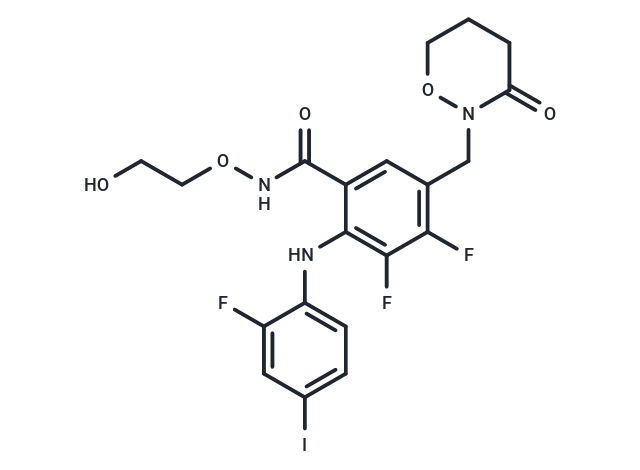Shopping Cart
- Remove All
 Your shopping cart is currently empty
Your shopping cart is currently empty

RO4987655 (RG7167) is an orally active and highly selective MEK inhibitor (IC50: 5.2 nM for MEK1/MEK2).

| Pack Size | Price | Availability | Quantity |
|---|---|---|---|
| 1 mg | $73 | In Stock | |
| 2 mg | $106 | In Stock | |
| 5 mg | $193 | In Stock | |
| 10 mg | $297 | In Stock | |
| 25 mg | $496 | In Stock | |
| 50 mg | $689 | In Stock | |
| 100 mg | $1,070 | In Stock | |
| 1 mL x 10 mM (in DMSO) | $238 | In Stock |
| Description | RO4987655 (RG7167) is an orally active and highly selective MEK inhibitor (IC50: 5.2 nM for MEK1/MEK2). |
| Targets&IC50 | MEK2:5.2 nM (cell free), MEK1:5.2 nM (cell free) |
| In vitro | CH4987655 (RO4987655) potently inhibits mitogen-activated protein kinase signaling pathway activation and tumor cell growth, with an in vitro IC50 of 5.2 nmol/L for inhibition of MEK1/2 [1]. In NCI-H2122 cells, RO4987655 at doses ranging from 0.1 to 1.0 μM suppressed pERK1/2 already at 2 h after the start of treatment. RO4987655 inhibited proliferation of NCI-H2122 cells in a dose-dependent manner with an IC50 value of 0.0065 μM [2]. |
| In vivo | In the dose-ranging study, treatment with RO4987655 5.0 mg/kg led to dramatic decrease in FDG uptake on day 1. The daily RO4987655, 2.5 mg/kg treatment were followed by PET examinations on days 1, 3, and 9 of the drug administration. The maximum decrease was observed on day 1, followed by a slight rebound on day 3. The effect plateaued thereafter to day 9 of treatment [2]. Doses of 0.5, 1, 2, 3, and 4 mg were safe and well-tolerated. A total of 26 adverse events (n = 15) were reported: 21 mild, 5 moderate, and none severe. Moderate adverse events were experienced by one subject at 1 mg (autonomic nervous system imbalance) and three subjects at 4 mg (diarrhea, abdominal pain, autonomic nervous system, and acne) [3]. |
| Cell Research | Cells were treated with various concentrations of RO4987655 for 72 h in 96-well plates and viable cells were quantified with Cell Counting Kit-8. For Western blotting, cells were treated with RO4987655 for indicated periods and lysed with cell lysis buffer containing a protease inhibitor cocktail, phosphatase inhibitor cocktails 2 and 3, and 1 mM PMSF. For detection of protein bands, the following were used as primary antibodies: pEGFR, EGFR, pMKK4, MKK4, pAKT, AKT, pERK, ERK, pMEK1/2, MEK, Cyclin D1, and actin. All protein bands were visualized with secondary antibodies labeled with HRP and ECL system by using ImageQuant LAS 4000 [2]. |
| Animal Research | A time interval of 20 to 24 h was used between daily RO4987655 administration and completion of PET imaging for each tumor-bearing mouse and for each PET imaging time point (day 0, 1, 3 and 9). Mice were fasted for 6 to 8 h prior to start of the imaging session. [18F] FDG (7 to 8 MBq per mouse, maximum volume of 200 μL) was administered to awake, warmed (37°C) mice by a bolus injection via the tail vein. Forty to sixty minutes after the tracer injection, the mice were administered with isoflurane, controlled by an E-Z anesthesia vaporizer. The mice were placed on a heated pad (37°C) on the camera bed, with most of the body volume in the field of view (7.68 cm). Emission data were collected for 20 min in list mode with a microPET Focus 120 scanner. Maximum standardized uptake values (SUVmax) of [18F] FDG uptake in the tumor were calculated and normalized to the administered activity (MBq/body weight, g). The drug effect on tumor metabolism was estimated as%SUVmax change to day 0 (baseline) [2]. |
| Alias | RG7167, CH4987655 |
| Molecular Weight | 565.28 |
| Formula | C20H19F3IN3O5 |
| Cas No. | 874101-00-5 |
| Smiles | OCCONC(=O)c1cc(CN2OCCCC2=O)c(F)c(F)c1Nc1ccc(I)cc1F |
| Relative Density. | 1.740 g/cm3 (Predicted) |
| Storage | Powder: -20°C for 3 years | In solvent: -80°C for 1 year | Shipping with blue ice. | ||||||||||||||||||||||||||||||
| Solubility Information | DMSO: 35 mg/mL (61.92 mM), Sonication is recommended. | ||||||||||||||||||||||||||||||
Solution Preparation Table | |||||||||||||||||||||||||||||||
DMSO
| |||||||||||||||||||||||||||||||

Copyright © 2015-2025 TargetMol Chemicals Inc. All Rights Reserved.